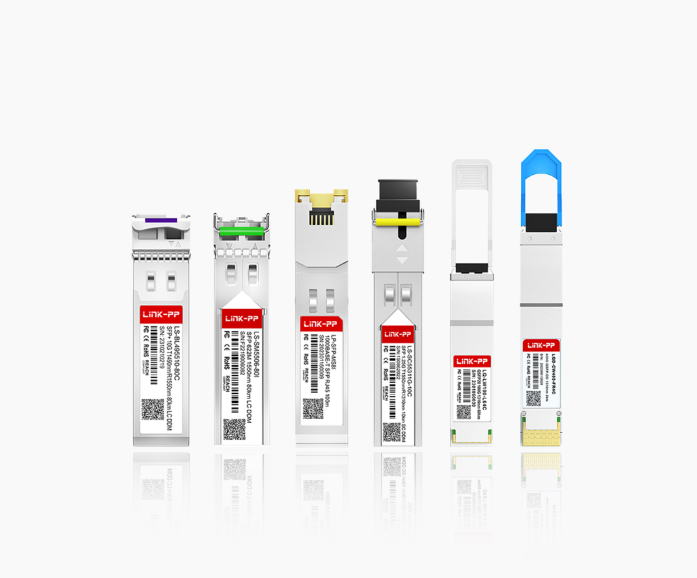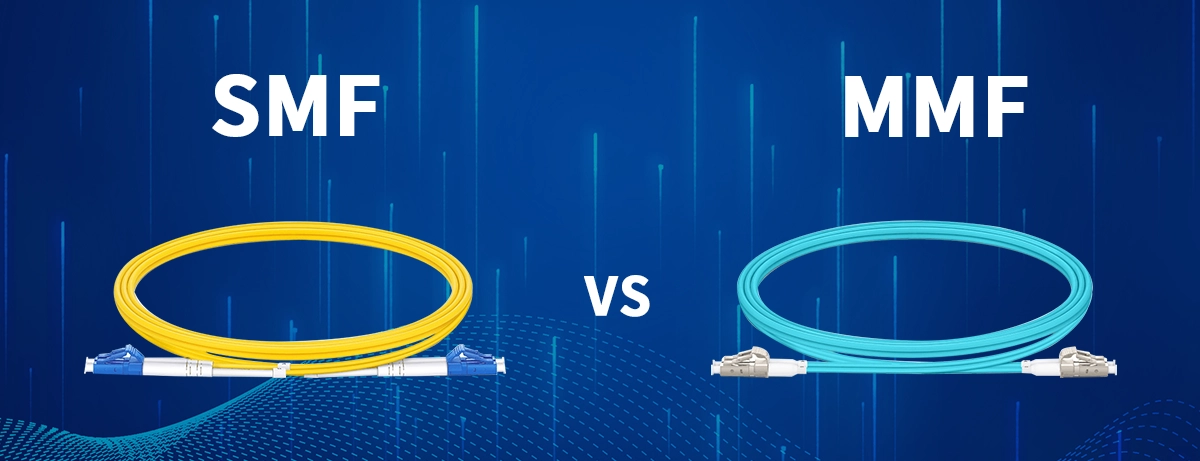
Understanding the fundamental differences between single mode fiber (SMF) and multimode fiber (MMF) is crucial when designing or upgrading network infrastructure. Both technologies transmit data using light pulses through glass or plastic fibers, but their core design, performance characteristics, and cost implications vary significantly, impacting application suitability. This guide delves deep into these differences to empower informed decision-making.
✦ Key Takeaways
Singlemode fiber has a small core. It sends light in one path. This makes it good for long distances. It is also good for fast data.
Multimode fiber has a bigger core. It lets light travel in many paths. It works well for short distances. It is also easier to set up.
Singlemode fiber gives more bandwidth. It loses less signal. It helps your network grow in the future. It is good for upgrades.
Multimode fiber costs less at first. It is good for local networks. It works well in data centers and schools. It is best for short cables.
You should pick the right fiber for your needs. Think about how far you need to go. Think about your budget. Think about how your network may grow.
✦ The Core Difference: Light Propagation Paths
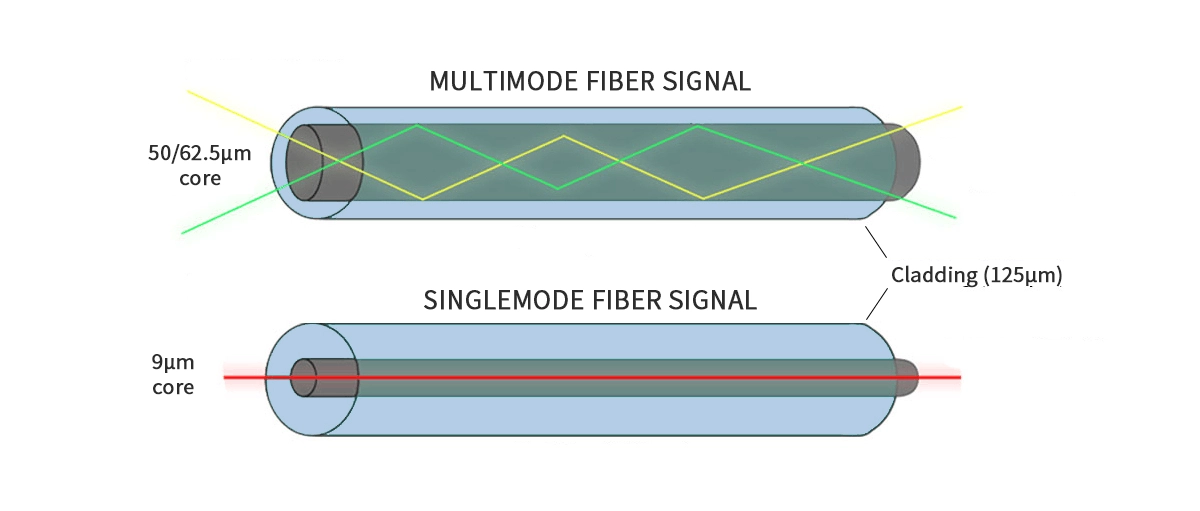
Single Mode Fiber (SMF): Features an extremely small core diameter, typically 9 micrometers (µm). This tiny core allows only one single path or "mode" for light to travel straight down the fiber. It typically uses laser light sources (1310nm or 1550nm).
Multimode Fiber (MMF): Has a much larger core diameter, commonly 50µm or 62.5µm. This larger size enables multiple light rays or "modes" to propagate simultaneously, bouncing at different angles within the core. It primarily uses Vertical-Cavity Surface-Emitting Lasers (VCSELs) or LEDs (850nm or 1300nm).
This core difference drives all subsequent performance variations:
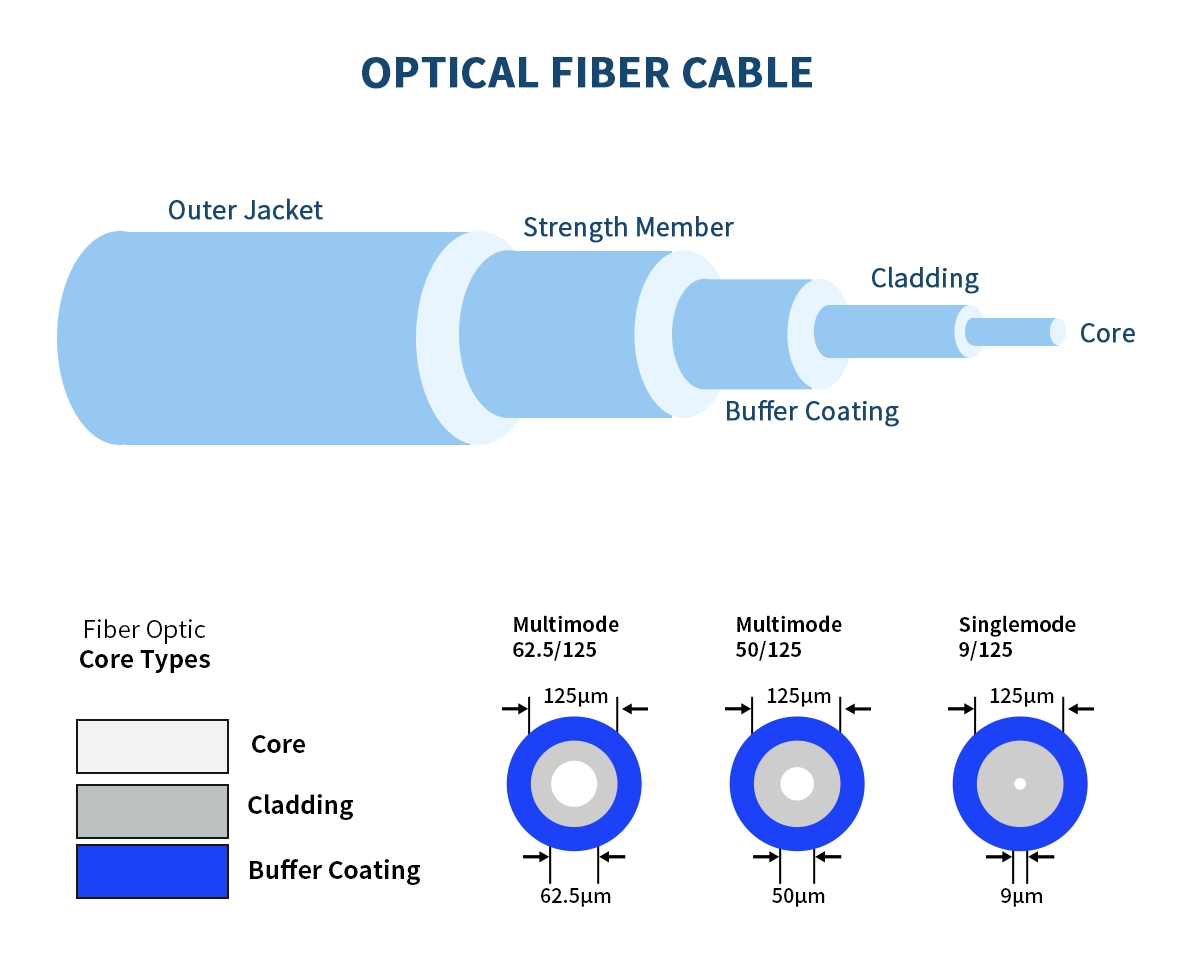
Feature | Single Mode Fiber (SMF) | Multimode Fiber (MMF) (OM3/OM4/OM5) |
|---|---|---|
Core Diameter | 9µm | 50µm or 62.5µm |
Light Source | Laser (1310nm, 1550nm) | VCSEL / LED (850nm, 1300nm) |
# of Light Paths | One (Fundamental Mode) | Hundreds (Multiple Modes) |
Typical Distance | 10km to 100+ km | 100m to 550m (Varies by speed/grade) |
Bandwidth | Very High (Effectively Unlimited) | High (Limited by Modal Dispersion) |
Attenuation | Lower (Especially at 1550nm) | Higher (Especially at 850nm) |
Modal Dispersion | Negligible | Primary Limiting Factor |
Cost (Fiber) | Higher | Lower |
Cost (Optics) | Higher (Lasers) | Lower (VCSELs) |
Primary Use Case | Long Haul, Telecom, Campus Backbone, Data Center Interconnect | Short Reach, Data Center Racks, Building Backbone, LANs |
✦ Key Performance Differences Explained
Transmission Distance:
SMF: The undisputed champion for long-distance transmission. With minimal signal degradation (attenuation) and virtually no modal dispersion (since there's only one mode), SMF can reliably carry signals for tens to hundreds of kilometers without needing regeneration. Ideal for telecom backbones, service provider networks, and large campus links.
MMF: Distance is significantly limited by modal dispersion. As different light modes travel varying path lengths, they arrive at the receiver at slightly different times, blurring the signal, especially at higher data rates. While laser-optimized MMF (OM3, OM4, OM5) improves this, practical distances for modern high-speed applications (40G, 100G, 400G) typically range from 100 meters to 550 meters. Best suited for shorter runs within buildings, data centers (rack-to-rack), and local area networks (LANs).
Bandwidth Capacity:
SMF: Offers vastly higher bandwidth potential. Its single-mode propagation eliminates modal dispersion, the main bandwidth limiter in MMF. While physical effects like chromatic dispersion exist, they are manageable, allowing SMF to support virtually any speed the optical transceiver technology can achieve, now and in the foreseeable future (400G, 800G, 1.6T+).
MMF: Bandwidth is limited primarily by modal dispersion. Fiber grades are defined by their "Effective Modal Bandwidth" (EMB). Newer grades like OM5 (Wide Band Multimode Fiber - WBMMF) offer higher bandwidth, especially using wavelength division multiplexing (WDM) techniques over short distances. However, bandwidth fundamentally decreases as distance increases for a given data rate.
Cost Considerations:
Fiber Cable Cost: MMF cable itself is generally less expensive than SMF cable.
Optical Transceiver Cost: This is where the balance shifts dramatically. The laser light sources (DFB, EML) required for SMF optical transceivers are inherently more complex and costly to manufacture than the VCSELs used in MMF transceivers. Therefore, MMF transceivers (e.g., SR, SR4, SR8) are typically significantly cheaper than their SMF counterparts (e.g., LR, ER, ZR) for equivalent data rates over short distances.
Total System Cost: For short distances (<500m), MMF systems often have a lower total installed cost due to cheaper optics. For longer distances, SMF becomes the only viable option, making its higher transceiver cost necessary. Future upgrade costs also favor SMF due to its virtually unlimited bandwidth headroom.
Applications: Choosing the Right Tool
Choose Single Mode Fiber (SMF) When:
Distances exceed 500 meters.
Future-proofing for higher speeds (400G, 800G+) is essential.
Maximum bandwidth over long distances is required (e.g., service provider networks, metropolitan area networks (MANs), large campus backbones, data center interconnect (DCI)).
Applications demand the highest possible signal integrity over distance.
Using long-reach optical transceivers like LINK-PP's 10G-LR, 25G-LR, 100G-LR4, or 400G-FR4.
Choose Multimode Fiber (MMF - OM3/OM4/OM5) When:
Distances are short (typically <= 100m-550m, check specific transceiver specs).
Cost optimization for the initial deployment is critical (especially optics cost).
Deploying within a single data center hall (rack-to-rack, rack-to-top-of-rack switch).
Running backbone links within a building or between nearby buildings on a campus.
Using cost-effective short-reach optical transceivers like LINK-PP's 10G-SR, 25G-SR, or 100G-SR4.
✦ LINK-PP Optical Transceivers: Matching the Fiber
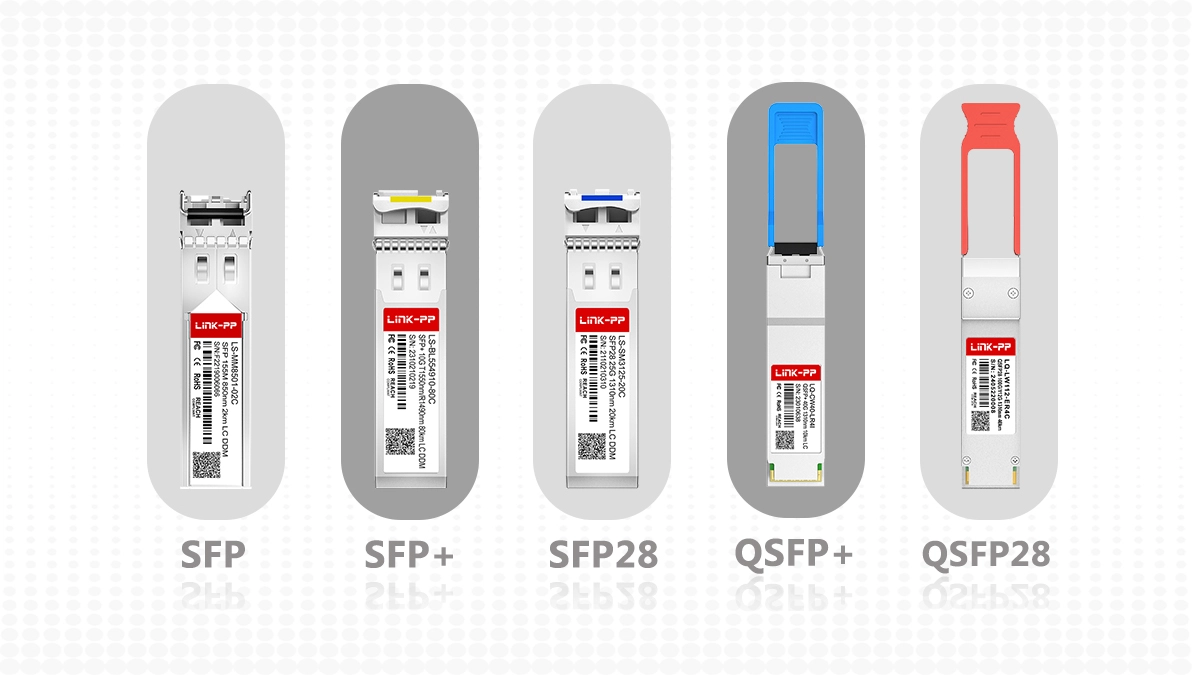
Selecting compatible optical transceivers is paramount. LINK-PP offers a comprehensive range designed for both SMF and MMF applications:
For Single Mode Fiber: Ensure you select modules with "LR" (10km), "ER" (40km), "ZR" (80km), or similar designations. Popular LINK-PP models include:
SFP+: SFP-10G-LR LS-SM3110-10C (10G up to 10km)
SFP28: SFP28-25G-LR LS-SM3125-10C (25G up to 10km)
QSFP28: QSFP28-100G-LR4 LQ-LW100-LR4C (100G up to 10km), QSFP28-100G-ER4 LQ-LW100-ER4C (100G up to 40km)
QSFP-DD: QSFP-DD-400G-FR4 LQD-CW400-FR4C (400G up to 2km), QSFP-DD-400G-LR4 LQD-CW400-LR4C (400G up to 10km)
For Multimode Fiber: Look for modules with "SR" (Short Reach) designations. Key LINK-PP models include:
SFP+: SFP-10G-SR LS-MM8510-S3C (10G up to 300m on OM3)
SFP28: SFP28-25G-SR LS-MM8525-S1C (25G up to 70m/100m on OM4/OM5)
QSFP28: QSFP28-100G-SR4 LQ-M85100-SR4C (100G up to 70m/100m on OM4/OM5)
QSFP-DD: QSFP-DD-400G-SR8 (400G up to 70m/100m on OM4/OM5)
✦ The Future: SMF Dominance for High Speed & Distance
While MMF continues to evolve (especially OM5 for short-reach WDM), the relentless demand for higher speeds (400G, 800G, 1.6T) over increasingly longer distances within and between data centers solidifies single mode fiber as the long-term strategic choice. Technologies like bidirectional transmission (BiDi) over a single SMF strand and coherent optics further enhance SMF's capabilities and cost-effectiveness for medium-range applications.
✦ Conclusion: It's About Application Requirements
There's no single "best" fiber. The optimal choice hinges on your specific needs:
Required Transmission Distance?
Target Data Rate (Now and Future)?
Budget Constraints (Fiber + Optics)?
For short, cost-sensitive links within a confined space, multimode fiber (OM4/OM5) paired with VCSEL-based optical transceivers remains a strong, economical solution. For demanding long-haul, high-bandwidth, or future-proof applications, single mode fiber is the essential backbone, leveraging powerful laser-based optical transceivers.
Ready to Optimize Your Fiber Infrastructure?
Choosing the right fiber type and compatible optical transceivers is critical for network performance and scalability. LINK-PP provides high-quality, reliable optical transceiver solutions engineered for both single mode and multimode deployments, ensuring seamless integration and optimal performance.
✦ FAQ
What is the main difference between single mode and multimode fiber?
Single mode fiber has a small core and sends light in one path. Multimode fiber has a larger core and lets light travel in many paths. This changes how far and how fast you can send data.
Can you mix single mode and multimode fiber in one network?
You should not mix them. The connectors and transceivers for each type are different. If you connect them, your network may lose signal or not work at all.
Which fiber type is better for future upgrades?
Single mode fiber works best for future upgrades. You can use it for higher speeds and longer distances. You only need to change the optics, not the cable.
Is multimode fiber easier to install?
Yes, multimode fiber is easier to install. The larger core makes it less sensitive to dust and alignment. You can finish the ends faster and with less skill.
Do single mode and multimode fibers use the same connectors?
Most connectors look the same, like LC or SC.
The inside part is different for each fiber type.
You must match the connector to the right fiber for the best results.




